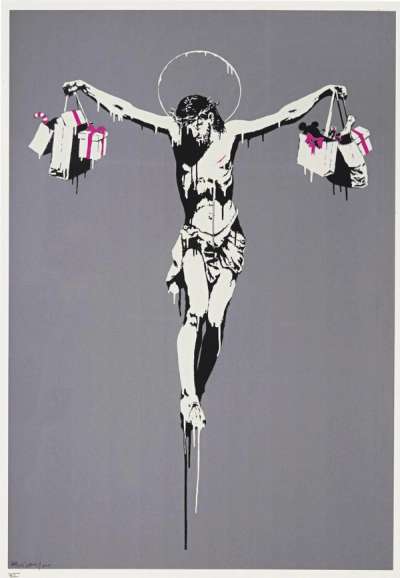Banksy’s Commandments

 What Do You Get The Man Who Has Everything? © Banksy 2005
What Do You Get The Man Who Has Everything? © Banksy 2005
Banksy
266 works
This series is a collaboration between Banksy's visual language and a witty contribution from British comedian Simon Munnery, which introduces a layer of comedic brilliance to the artist’s work. It emerges as other thought-provoking pieces from Banksy's prolific 2005 repertoire, distinctly shedding the artist's usual visual narratives for a piercing textual critique, blending the latter’s critical eye with Munnery’s sharp wit to create a series of artworks that challenge societal norms with humour and insight. Instead of a more elaborate narrative, Banksy opts for a minimalist approach that emphasises the explicit message over the medium.
Meaning and Analysis
Done in spray paint on repurposed wood, the simplicity and starkness of the materials allow for the humorous quotes to fully shine, showcasing the artist's versatility and commitment to messaging over medium in the entirety of his oeuvre. The decorative initials in each sentence nod to the traditions of manuscript illumination and evoking classic novels and fables, infusing the piece with an ironic reverence that contrasts sharply with its message.
What Do You Get The Man Who Has Everything?
An exploration of societal norms and capitalist critique, Banksy's What Do You Get The Man Who Has Everything? was created in 2005 and relies on a stark, textual message that slices through the facade of material abundance. The work is a compelling synthesis of humour and critique, presenting a poignant inquiry into the ethos of consumer culture: “What do you get the man who has everything? Might I suggest a gravestone inscribed with the words: so what?” This rhetorical jest is a profound reflection on the emptiness that often accompanies material wealth. Through this piece, Banksy challenges the viewer to reconsider the value of possessions and the ultimate cost of relentless consumerism, as it reflects on the societal obsession with accumulation and the superficial satisfaction it brings. Banksy's commentary on capitalism is as incisive as it is succinct, encapsulating the paradox of seeking solace in shopping while recognising its futility in changing our common end.
You Can’t Fool All Of The People…
This work brandishes a sharp, tongue-in-cheek commentary at its core, directly confronting the viewer with a candid reflection on the pervasive influence of advertising in our lives: “You can’t fool all of the people all of the time but you can try. It’s called advertising.” With this piece, Banksy strips down his medium to the bare essentials, allowing the message itself to command full attention. It is a direct jab at the heart of capitalist culture's more insidious aspects – manipulation and commodification – echoing themes similarly explored in other of Banksy’s Commandments. Through this stark departure from his norm, Banksy amplifies his critique, suggesting that the art of deception is an industry in and of itself, woven intricately into the fabric of everyday life. This artwork serves as a vehicle for Banksy’s dark humour to dissect and critique the mechanisms of capitalism, shedding light on how societal values and desires are shaped and manipulated.
Do Not Punish Yourself
Do Not Punish Yourself delivers a compelling meditation on self-censure and cultural expectation, distilling Banksy's penchant for societal critique into a singular poignant phrase: "Do not punish yourself. You deprive the world of its purpose". It carries a dual tone – initially appearing as a reassurance, upon deeper reflection it reveals a critique of societal structures that impose a sense of guilt and inadequacy. Through this, Banksy aligns himself with a long history of critique embedded within art, simultaneously challenging the viewer to reconsider the role of punishment and guilt in a capitalist society. By paring down to the essence of the message, Banksy crafts a space for reflection on the cycles of self-reproach, encouraging a reconsideration of what truly gives life its purpose.
Sex, If You Want It Badly…
Sex, If You Want It Badly… is a testament to the artist's ability to provoke thought and invite reflection on the complexities of human desire through irony. The clever wordplay embedded within "Sex. If you want it badly, that’s how you’re going to get it" stretches beyond a mere pun, contrasting the “want badly” to “wanting something done badly.” This juxtaposes the fervent desire for intimacy with the unfortunate reality of its poor attainment, a duality that resonates with the commodification of human connections in contemporary society. This humorous observation on the nature of longing and desire offers a fresh perspective on the themes that have long defined Banksy’s oeuvre.
Many Drink To Forget
This piece, much like its contemporaries within the Commandments series, leverages the power of words to confront and unsettle, solidifying Banksy's stature as a profound commentator on the human condition. Here, Banksy distils his critique of capitalist excess and the self-medication habits of society into a concise, powerful statement: “Many drink to forget, few forget to drink.” It underscores the cyclical nature of consumption and the ironic escapism found in the act of drinking, highlighting how societal pressures and capitalist culture drive individuals towards such habits as a form of solace or forgetfulness. The simplicity of the message, combined with the choice of medium, reinforces Banksy's message about the pervasiveness of excess and the superficial attempts to escape it. By isolating this phrase, Banksy elevates it to a symbol of wider societal issues, compelling the viewer to confront the realities of their coping mechanisms within a consumer-driven world.
“Commandments marks a departure from the artist's typical visual storytelling to a more text-based critique, highlighting Banksy's adaptability and his primary focus on messaging.”

Banksy’s Commandments: Exhibition History
Santa’s Ghetto, London 2005
















